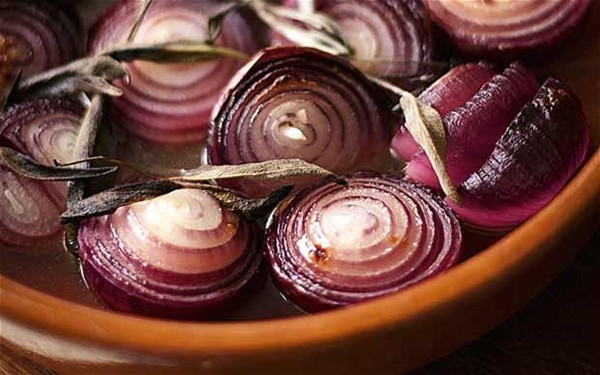What James Beard had to say about onions
July 15, 2018 by DarcieOnions are indispensable in my kitchen. I usually have at least two types on hand at any given moment (red and yellow) and frequently even more. They are essential to many dishes. I’m far from the only fan of onions, of course; they are favored by home cooks and chefs alike. One of the onion’s biggest fans was James Beard, who wrote about this subject and many more in his iconic book Beard on Food. The James Beard Foundation just posted an excerpt from the book regarding onions, and it makes for a wonderful read.

Beard notes that onions form the backbone of dishes from many cultures and provides us with examples of how onions have been venerated throughout the ages: “Onions, we are told, were part of the cargo on Noah’s ark. The Egyptians regarded them as a symbol of the sun they worshiped as a god, with the concentric rings of the sliced onion representing heaven, hell, earth, and the universe. If you’ve never studied the inside of an onion, cut one in half sometime and really look. It is one of nature’s most amazing works of art.”
The essay provides myriad ways to enjoy different types of onions – in a salad, pickled, or even on their own as a sandwich. Beard adored onion sandwiches, preferring sweet onions grown in Washington State and Idaho (undoubtedly the Walla Walla variety). As much as he loved onions, Beard shared the lament that many of us have about the tasty but fussy pearl onion, noting that “peeling these babies is a pretty monotonous task.”
Naturally, the EYB Library is stuffed with onion recipes. These alliums are included in over 41,000 online recipes. A few highlights are listed below. One of my favorite onion recipes is the Golden onion & thyme dip from Fine Cooking Magazine. What’s your favorite way to enjoy onions?
- French onion soup with Gruyère toasts from Masterchef Australia
- Indian onion fritters (Onion bahji) from Serious Eats
- Onion, anchovy and olive tart from Off the Shelf by Donna Hay
- Warm tomato, onion and bread salad with beef dripping dressing from Tom Kerridge’s Proper Pub Food by Tom Kerridge
- Cider and sage roast onions from Diana Henry at The Sunday Telegraph by Diana Henry (pictured above)
Categories
- All Posts (6940)
- Antipasto (2135)
- Author Articles (247)
- Book News (935)
- Cookbook Giveaways (983)
- Cookbook Lovers (257)
- Cooking Tips (109)
- Culinary News (299)
- Food Biz People (552)
- Food Online (791)
- Holidays & Celebrations (272)
- New Cookbooks (149)
- Recipes (1500)
- Shelf Life With Susie (231)
- What's New on EYB (133)
Archives
Latest Comments
- eliza on What foods do you look forward to the most for each season?
- kmwyman on Rooza by Nadiya Hussain – Cookbook Review and Giveaway
- Maryd8822 on The Golden Wok – Cookbook Giveaway
- Dendav on Danube Cookbook Review and Giveaway
- sanfrannative on Rooza by Nadiya Hussain – Cookbook Review and Giveaway
- darty on Danube Cookbook Review and Giveaway
- Atroyer7 on Danube Cookbook Review and Giveaway
- demomcook on What foods do you look forward to the most for each season?
- demomcook on Danube Cookbook Review and Giveaway
- Darcie on How cookbooks can help build resilience